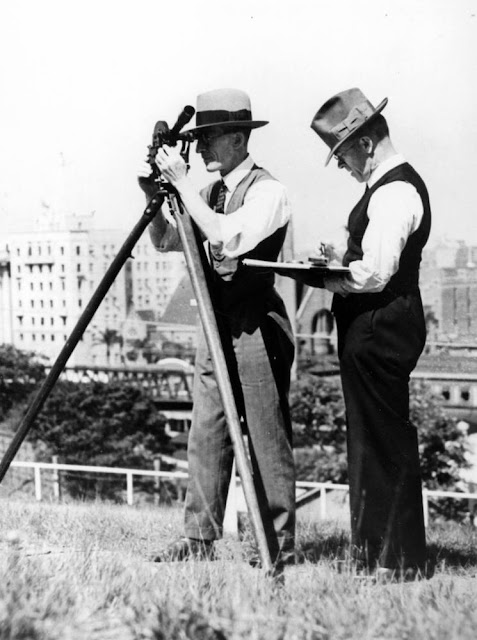Source: National Archives of Australia, Image Number: J2669:551
This is a lost gem. Completed in 1938, the Brisbane Meteorological Office was a handsome cement rendered building on the corner of Wickham Terrace and Upper Edward Street. It was designed by the Queensland Department of Public Works and carries their signature stripped classical rectitude. I haven't discovered when it was demolished but it was still there in 1974. The site is currently occupied by a huge horrendous residential tower 'Observatory Tower'.
View along Wickham Terrace with the Weather Bureau building at centre.
Source: NLA, Image Number: 6850793177.
The first Government Meteorologist began formally and continuously gathering weather data in Brisbane in 1887. The Weather Bureau was housed within a small timber building within an open site on the Wickham Terrace ridge and utilised the nearby Old Tower Mill as a highpoint for gathering data.
The Weather Bureau building was used for over 50 years.
Source: SLQ, JOL, Negative Number: 161106.
By the interwar years the Weather Bureau building was grossly inadequate and was truly outdated, being called ancient in an 1938 newspaper report. Weather data was a national concern, important for the new and expanding aviation industry.
Weather spunks, c1937.
Source: SLQ, JOL, Negative Number: 161209.
The building was a scientific establishment and considered 'probably the best in Australia' at the time. It contained a 'comfortable flat' on the second floor for the Divisional Meteorologist and a tower to gather data. All of the weather records that had been scattered in government storerooms over the city were moved into the building when it opened in 1938. The technological leap from 1880s timber and tin shed to a monumental state-of-the-art laboratory was impressive and the papers crowed about how Brisbane was ahead of the other state capitals.
'On the wall is an indicator ... marked with the letters N S E W. Beside each letter is a small coloured bulb. A switch is turned on and the lights immediately indicate the direction of the wind.' (Source: The Courier-Mail 22 November 1938, page 6)
Far out!
The warm tan of cement render after 50 years of mellowing. Mmmmm. Bulldoze it!
Source: NLA,Image Number: A6135:K2/5/74/3
I've found surprisingly few photos of the building considering its importance and prominent location. It's a huge shame that this incredible building is lost.





Looking for courier quote ?
ReplyDeletefreight quote
tnt quote
couriers please quote
air freight
couriers quote